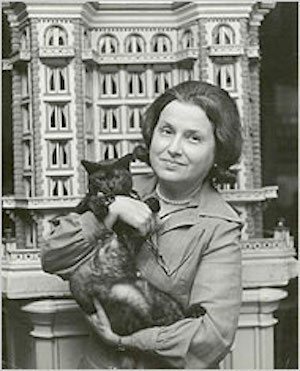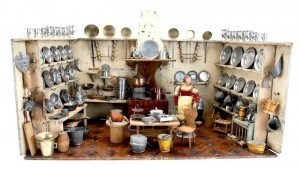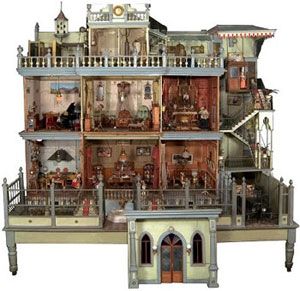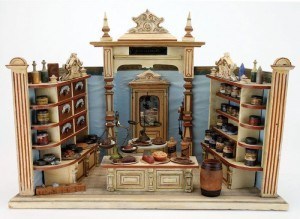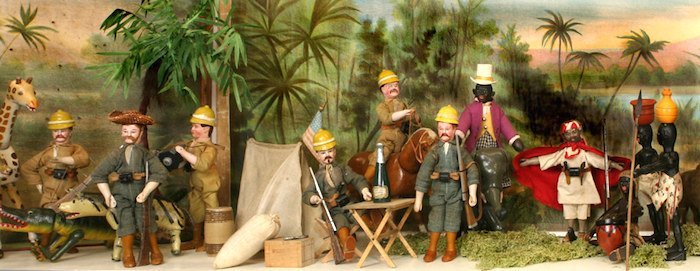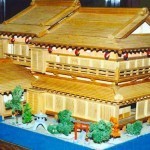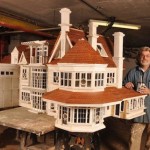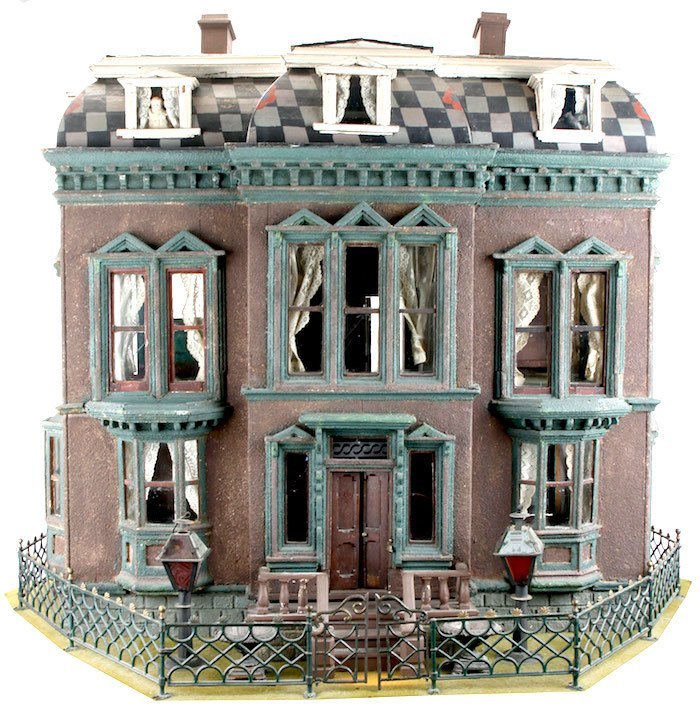
The South Jersey House, Flora Gill Jacobs collection
Flora Gill Jacobs, 87, Who Opened Dollhouse Museum, Dies
By MARGALIT FOX
Published: June 12, 2006
Flora Gill Jacobs, an internationally recognized authority on dollhouses who spent her adult life blissfully awash in minutiae, including tiny, lavishly appointed mansions and an ornate Mexican villa that came with its own chapel (very small priest included), died on May 31 in Washington. She was 87 and lived in Chevy Chase, Md.
Flora Gill Jacobs, shown in 1980, ran the Washington Dolls’ House and Toy Museum. She began her collection in 1945 with a $35 purchase.
The cause was congestive heart failure, her family said.
For many years, Ms. Jacobs presided over the Washington Dolls’ House and Toy Museum, which she founded in 1975 and ran for nearly three decades, usually at a loss. Her work and her writings were credited with creating interest in dollhouse collecting in the United States in the second half of the 20th century.
While there are many museums of dolls in this country, Ms. Jacobs’s, a result of six decades of ardent collecting, was believed to be the first here devoted primarily to dolls’ homes. In its heyday, it attracted more than 20,000 visitors annually, most of them adults.
Six days a week, Ms. Jacobs went to the museum to fuss, dust and instruct. As she told The Washington Post in 1988, “I hardly ever go out into the life-size world.”
She closed the museum in 2004, citing rising costs and advancing age.
A newspaperwoman by training, Ms. Jacobs wrote many highly regarded books on dollhouses, among them “A History of Dolls’ Houses: Four Centuries of the Domestic World in Miniature” (Scribner, 1953); “Dolls’ Houses in America: Historic Preservation in Miniature” (Scribner, 1974); and, most recently, “The Small World of Antique Dolls’ Houses” (Lake Isle Press, 2005).
The first known dollhouse was made in the mid-16th century, and since then dolls’ houses have inflamed the acquisitive passions of generations of collectors. A dollhouse lets its owner preside over a miniature cosmos. It affords control, or at least the illusion of it, in a disorderly world. One can make all the aesthetic decisions, and do all the wiring, without ever having to argue with contractors.
The finest dollhouses have electric lights that turn on; running water (cold, usually); libraries with tiny printed books that can be taken down and read; and kitchen stoves that can be fired up. They can contain ornate chandeliers; scaled-down fine furniture; minute sterling tea sets; and little household pets, often made from fur-coat scraps.
For Ms. Jacobs, the attraction went beyond even these things. To her, an antique dollhouse was social history in microcosm, offering a meticulous record of the architecture and decorative arts of its era. And today, with many real historic buildings falling to the wrecker’s ball, dollhouses, as she often said, offer a small way of preserving the past.
Flora Gill was born in Washington on Dec. 22, 1918. Growing up, she did not have a dollhouse, but the girl next door did ― a magnificent one that her father, a soldier in World War I, had brought back from Germany.
While Flora was still a student at George Washington University, she wrote film reviews for the old Washington Times-Herald. She left college for a job on the paper, eventually becoming the fashion editor. She later went to work as a reporter for The Washington Post, where she was assigned to the women’s page.
In 1940, she married Ephraim Jacobs. He survives her, along with their daughter, Amanda, of Centreville, Md.
Leaving The Post after several years, Ms. Jacobs decided to write a book about dollhouses and, not long afterward, decided she had better own one. She bought her first from a New Jersey antique shop in 1945. A derelict post-Civil War sandstone with a mansard roof, it cost $35.
At the time, dollhouses were unfashionable things in the world of collectibles. “Most antique dealers didn’t even know what I was talking about,” Ms. Jacobs told The Washington Times in 1999. “One thought I was looking for doghouses.”
As her collection grew, friends clamored to see it. So did friends of friends. Brownie troops trooped through. Eventually, Ms. Jacobs’s houses outgrew Ms. Jacobs’s house. She rented a small building in northwest Washington, and the museum was born.
Comprising about 40 dollhouses from the 18th to the early 20th centuries, the museum’s collection focused on Victoriana. The star attraction was the multistory Mexican villa, built circa 1890. Besides the chapel, it had roof gardens, an aviary, a working elevator and a gated driveway with a vintage Paige touring car.
Among the other miniature buildings on display were a dentist’s office, a milliner’s shop, and a seaside hotel. There was a tiny circus and a tableau of Teddy Roosevelt on safari in Africa that featured porters, a naturalist, and a menagerie that, somewhat incongruously, included a kangaroo.
Ms. Jacobs, who lectured throughout the world on dollhouse history, also wrote several children’s books inspired by her work, among them “The Doll House Mystery” (Coward-McCann, 1958) and “The Toy Shop Mystery” (Coward-McCann, 1960).
In May 2004, the contents of the museum were sold at auction for about $1.4 million. The Mexican villa alone brought $231,000, said Noel Barrett, a dealer in antique toys who handled the sale.
It was hard for Ms. Jacobs to see her dollhouses go, but she had ample consolation at home. There, she had a collection as big as ― by some accounts bigger than ― the one at the museum.
Susan Downing, with Patrick Owens
_________________________________________________________________________
I invite you to visit my Etsy Shop where I offer many accessories and pieces of furniture in 1:12 scale.


